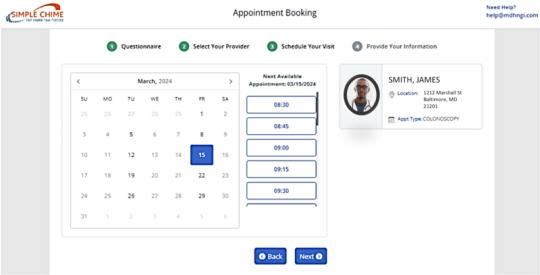#Falkondata
Explore tagged Tumblr posts
Text
2024: The Dawn of Interconnected Healthcare

Envision a world where medical records seamlessly traverse between hospitals, medical practices, and pharmacies, guiding care decisions. Healthcare's future shines bright in 2024, illuminated by three major trends poised to revolutionize how we experience and deliver health: interoperability, revenue cycle management (RCM) optimization, and empowered patient engagement.
Interoperability
The longstanding aspiration of unlocking healthcare data is finally becoming a reality. After years of anticipation, 2023 witnessed the momentous launch of the nationwide data exchange powered by TEFCA (Trusted Exchange Framework and Common Agreement). This landmark framework acts as a key, unlocking data silos and allowing medical records to flow freely across different healthcare systems nationwide. This unprecedented data liberation promises to harmonize care coordination, drastically reducing medical errors and eliminating redundant tests. The future of healthcare looks brighter than ever, with patients empowered to actively participate in their own journey by easily accessing their complete medical picture across disparate providers.
RCM Evolution
Picture cloud-based RCM platforms powered by AI automation, where bills are personalized, claims processed seamlessly, and denials tackled proactively. We are well on the path to realizing this vision. According to a recent survey conducted by Change Healthcare, 98% of healthcare leaders across the US plan to leverage AI across their revenue cycle within the next three years. This aligns with several other studies from organizations like HFMA and NBER, all highlighting the rising adoption of AI for tasks like automated claims processing, personalized billing, and proactive denial management. This growing focus on AI-powered RCM is fueled by its potential to support value-based care models, where providers are rewarded for improved patient outcomes rather than just the number of procedures performed.
Patient Engagement, Redefined
With virtual care models taking center stage, AI advances like Google’s PaLM2 and others are fueling a patient-centric healthcare revolution. Robust language models tailor interventions, while intelligent assistants handle appointments and provide real-time support. The healthcare landscape is transitioning from hospital to the comfort of our homes, empowered by convenient virtual consultations and remote monitoring.
Beyond the Horizon
This glimpse into the healthcare landscape of 2024 is just the first act. Picture wearable sensors feeding real-time health data into AI-powered models that predict and prevent illnesses. The possibilities are limitless, driven by ongoing technological advancements and an unwavering commitment to patient-centered care.
So, buckle up. We stand on the precipice of a transformative era where data intertwines with innovation, finances align with outcomes, and patients rightfully take center stage in their well-being. The future of healthcare is not merely interconnected – it's genuinely human-centric, and 2024 is only the beginning.
Ready to make this journey easier? Reach out to Falkondata and discover how we can streamline your process and achieve your goals.
#ehr#future of healthcare#health and wellness#AdvancedMD#Falkondata#interoperability#EHR Integration#FHIR#health tech#patient care#medical billing services#healthcare industry#hl7
0 notes
Text
A Cheat Sheet for EHR Data Conversion and Migration

Bid farewell to data headaches and embrace a seamless transition between Electronic Health Record (EHR) systems! Moving to a new Electronic Health Record (EHR) can feel like scaling Mount Data Everest, but fear not, brave healthcare hero. This cheat sheet is your trusty sherpa, guiding you through the tricky terrain of data conversion and migration.
Before You Begin
Investigate how both your current and future EHR systems handle data export and import. Is it a database dump, APIs, or file transfers? The sooner you understand, the smoother the migration.
Do not assume that all data is easily transferable. Scrutinize your data to ensure it meets the new system’s requirements, as not all elements may seamlessly make the journey.
Don’t rely on cumbersome claim transfers. Wrap up outstanding accounts receivable in your old system before making the switch.
Schedule your migration around holidays to minimize disruption and give your team (and the data!) breathing room.
Conversion Strategies
Embrace a phased approach. Move demographics, appointments, and master lists first. Clinical data can wait (gasp!). This lets your team and the new EHR prioritize and get you online ASAP.
Conduct multiple tests, running trial conversions on small patient samples (say 30 patients). You’ll unearth issues before they become mountain-sized problems.
Consider retaining temporary access to your old system for reference purposes. It’s like a safety net for those “oh, I forgot that!” moments.
Not everything needs a new home. Utilize an archival system for data you don’t need in the new EHR.
Data Essentials
Ensure a smooth migration by prioritizing the transfer of the following essential data:
Patient Information: Demographics, insurance scans, policy details, historic charges/balances.
Appointments: Both past and future appointments, meticulously organized.
Master Lists: Categorize and transfer insurance providers, referral sources, and other relevant lists.
Clinical Data: Chart PDFs, discrete text data, allergies, medications, problem lists, immunizations, and progress notes.
Procedures: Transfer detailed information such as CPT codes, modifiers, and pre-authorization codes.
CCDAs: Acquire the Summary of Care document, a valuable data repository.
Financials: Limited financial data may be transferred, but confirm the specifics with your new EHR to ensure accuracy.
Bonus Tip: Make a list of all your EHR integration points like FHIR, HL7 V2, APIs, CSV files. Don’t leave any data orphans behind!
But fear not, weary traveler! You don’t have to climb this mountain alone. We’re here to help with expert guidance, proven strategies, and a team of data Sherpas ready to tackle any conversion challenge. Contact us today for a free consultation and let’s turn your EHR migration into a smooth and stress-free journey!
Remember, with the right plan and a helping hand, even the mightiest data peak can be conquered.
You may find this article on Falkondata website by following this link: https://falkondata.com/ehr-data-conversion-cheat-sheet/
2 notes
·
View notes
Text
Patient appointment management efficiency

In today’s fast-paced healthcare environment, managing appointments efficiently is crucial for both patient care and operational success.
𝐓𝐡𝐞 𝐂𝐡𝐚𝐥𝐥��𝐧𝐠𝐞 A large dermatology clinic struggled with a high rate of patient no-shows, significantly impacting their revenue and operational efficiency. Despite sending email reminders and making phone calls, the clinic was unable to reduce the no-show rate effectively.
𝐓𝐡𝐞 𝐒𝐨𝐥𝐮𝐭𝐢𝐨𝐧
The clinic decided to implement 𝐅𝐚𝐥𝐤𝐨𝐧𝐃𝐚𝐭𝐚'𝐬 𝐒𝐢𝐦𝐩𝐥𝐞𝐂𝐡𝐢𝐦𝐞 solution, a powerful tool designed to manage appointments through automated text messaging. The goal was to reduce no-shows by making it easier for patients to remember and manage their appointments.
𝐈𝐦𝐩𝐥𝐞𝐦𝐞𝐧𝐭𝐚𝐭𝐢𝐨𝐧
1. 𝑹𝒆𝒔𝒄𝒉𝒆𝒅𝒖𝒍𝒊𝒏𝒈 𝑳𝒊𝒏𝒌𝒔: For patients who missed their appointments, SimpleChime sent an automated text with a link to an online scheduling portal, making it easy for them to rebook. 2. 𝑾𝒂𝒊𝒕𝒍𝒊𝒔𝒕 𝑴𝒂𝒏𝒂𝒈𝒆𝒎𝒆𝒏𝒕: SimpleChime automatically sends bulk messages to waitlisted patients when a patient cancels, quickly filling the slot. 3. 𝑩𝒖𝒍𝒌 𝑴𝒆𝒔𝒔𝒂𝒈𝒆𝒔: Allowing an ability to bulk messages saves time and reduces administrative overhead, allowing staff to focus on delivering excellent care.
𝐑𝐞𝐬𝐮𝐥𝐭𝐬
After implementing SimpleChime, the clinic saw a remarkable improvement in their appointment management:
- 𝑵𝒐-𝑺𝒉𝒐𝒘 𝑹𝒂𝒕𝒆 𝑹𝒆𝒅𝒖𝒄𝒕𝒊𝒐𝒏: The no-show rate dropped by 40% within the first three months. - 𝑰𝒏𝒄𝒓𝒆𝒂𝒔𝒆𝒅 𝑹𝒆𝒗𝒆𝒏𝒖𝒆: By filling previously missed appointments, the clinic saw a significant increase in revenue. - 𝑬𝒏𝒉𝒂𝒏𝒄𝒆𝒅 𝑷𝒂𝒕𝒊𝒆𝒏𝒕 𝑬𝒙��𝒆𝒓𝒊𝒆𝒏𝒄𝒆: Patients appreciated the convenience of managing their appointments via text messages and the ease of rescheduling missed appointments.
𝐅𝐚𝐥𝐤𝐨𝐧𝐃𝐚𝐭𝐚'𝐬 𝐒𝐢𝐦𝐩𝐥𝐞𝐂𝐡𝐢𝐦𝐞 𝐬𝐨𝐥𝐮𝐭𝐢𝐨𝐧 proved to be a game-changer for the dermatology clinic. By leveraging automated text messaging, the clinic was able to reduce no-shows, fill cancelled slots efficiently, and ultimately increase its revenue.
If you are a healthcare provider concerned about no-shows affecting your practice, contact FalkonData to learn how SimpleChime can help you manage appointments more effectively.
0 notes
Text
A Guide to Healthcare Data Integration & Improved Patient Care
Demystifying the New CMS Prior Authorization Rule
The healthcare landscape is evolving rapidly, driven by a focus on streamlining processes, empowering patients, and delivering quality care efficiently. The new prior authorization rule, with its emphasis on the HL7 FHIR data integration standard, is a pivotal step in this direction. But navigating these complexities can be challenging for healthcare providers and payers alike.
This is where Falkondata, with its expertise in healthcare data integration and interoperability, comes in as your trusted partner.
Here are some frequently asked questions about this new rule:
Q: What is the new rule by the Centers for Medicare & Medicaid Services (CMS) about?
A: The new rule by CMS is about improving healthcare data exchange and prior authorization processes. It aims to streamline the prior authorization process, improve data exchange between providers and payers, and give patients more access to their health information. The new rule requires payers to support HL7 FHIR® Prior Authorization API data integration standard and/or X12 278 transaction standard.
Q: How will the HL7 FHIR Prior Authorization API improve the process?
A: This API automates the entire prior authorization process electronically, saving time and reducing administrative burden for both providers and payers. Medicare FFS already uses this API successfully, demonstrating its efficiency.
Q: What about the X12 278 standard? Is it mandatory?
A: While the rule encourages the use of FHIR API, it offers flexibility. Payers who implement a fully FHIR-based API won't be penalized for not using X12 278, allowing them to choose an FHIR-only or combined approach. They can also offer an X12-only option if desired.
Q: What other API requirements are included?
A: By January 2027, payers must:
Expand their Patient Access API to include prior authorization information.
Implement a Provider Access API for data retrieval (claims, encounters, clinical data, prior authorizations).
Exchange patient data (with permission) via Payer-to-Payer FHIR API when patients switch payers or have multiple ones.
Here are all the APIs healthcare payers should implement:

Here is a link to the chart of proposed and current API standards.
Q: How will these changes benefit patients and providers?
A: These data integration efforts aim to:
Reduce administrative burden for healthcare professionals.
Allow clinicians to spend more time on direct patient care.
Prevent delays in care for patients needing prior authorization.
Improve access to health information for patients and providers.
Q: What about the enforcement of these standards?
A: HHS will enforce the use of the FHIR API for prior authorization. However, they offer enforcement discretion for the X12 278 standard, allowing flexibility in implementation.
Q: Is there anything else to know about this rule?
A: The API compliance deadline has been delayed from January 2026 to January 2027 due to public feedback. Additionally, a new Electronic Prior Authorization measure is being added to MIPS and the Medicare Promoting Interoperability Program to track API usage.
By implementing these standards and promoting data exchange, the goal is to create a more efficient prior authorization process, improve access to health information, and ultimately deliver better, timelier care to patients.
Q. How can Falkondata help with this new rule?
A: The new healthcare rule mandates data integration standards like HL7 FHIR and X12 278 to revolutionize prior authorization, but navigating these complexities can be daunting. That's where Falkondata steps in.
We are healthcare data integration experts:
Proven track record: Successfully implemented various FHIR, HL7 messages, and X12 interfaces.
Deep understanding: We grasp provider and payer workflows for seamless integration.
Comprehensive service: We help implement provider, patient, and prior authorization APIs, ensuring compliance and efficiency.
Embrace the benefits:
Reduce administrative burden: Free up valuable time for healthcare professionals.
Empower patients: Enhance access to health information and faster care delivery.
Boost efficiency: Streamline prior authorization processes with automated solutions.
Don't wait to adapt. Contact Falkondata today to discuss your project and:
Simplify compliance: Ensure smooth implementation of data integration standards.
Optimize workflows: Enhance provider and payer communication for better patient care.
Unlock the future: Embrace the evolving healthcare landscape with confidence.
Together, let's build a more efficient and patient-centric healthcare system.
0 notes